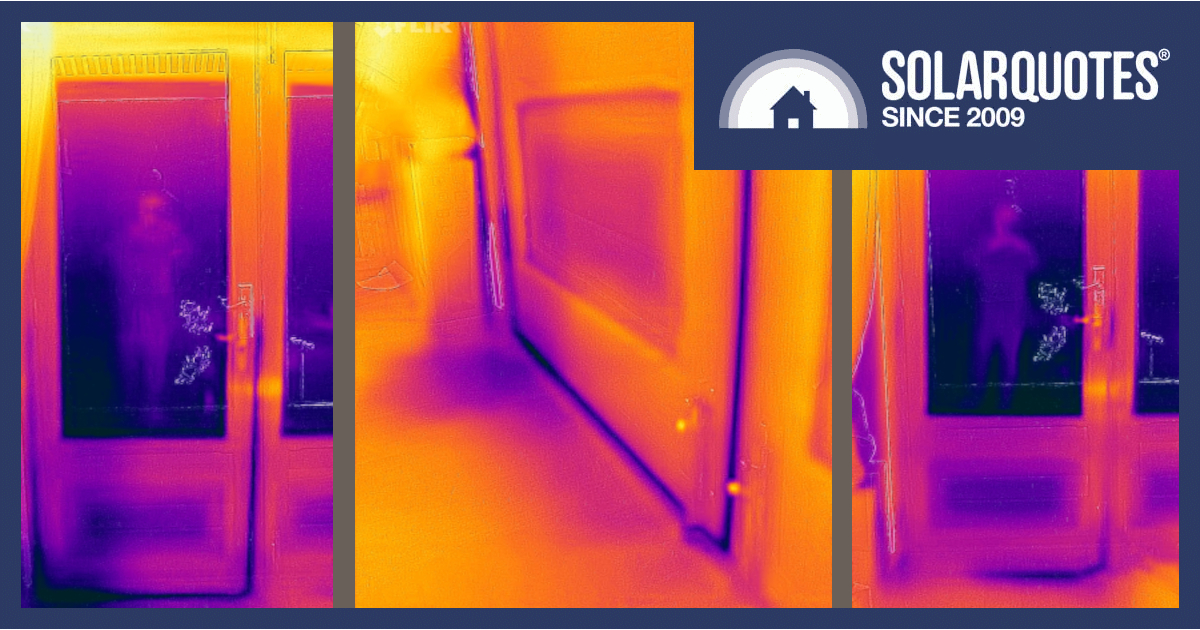
They might look nice, but French doors are a leaky liability. Draft-proofing has been a winner for me (note the lack of a dark blue line around the doorframe in the right-hand ‘after’ pic).
The winter solstice is upon us, bringing dismal weather to Adelaide and much of Australia. And in other shocking news, water is wet.
Equally distressing is the impending wave of power price rises on the horizon, and since economic vandals decided to sell all our gas for next to nothing, heating is expensive. Even if you already have a solar panel system helping to power your heating, a poorly insulated home is still a money pit.
But how are average Aussies holding up? And what can you do to make things a little cosier without pouring more money into heating? Let’s take a snapshot of Australia in these chilly winter months.
Australians Build Rubbish Houses
There I said it, come at me building industry. I’ve been taking notes from my favourite social threads recently, and I’ll paraphrase a few discussions from some energy-efficiency enthusiasts. Some are even what you might call ‘professionally frugal’.
The frigid winter has set in – the reverse cycle split air conditioners are working at full tilt and the heat pump hot water service is humming away too.
Outside, it’s 3.7ºC, feeling more like a biting 2.3ºC – a reality that the air conditioners are battling. I estimate they’re managing an average Coefficient of Performance (COP) of 2.5 under these conditions, meaning we’re pushing approximately 25kW of heat into the building right now.
It was cold throughout the day and our 26.6kW solar panels produced a modest 37kWh, with consumption so far at 47kWh. I anticipate another half hour of heating tonight and a challenging morning as the air conditioners are likely to freeze up.
The takeaway? Winters in Victoria can be brutal. How is everyone else managing?
That was a report from Karl Jensen, an avid electrification evangelist and inimitable solar industry figure who thinks iStore heat pump hot water services are the best thing ever. You’ll get full disclosure that he wholesales them, but only after he’s delivered a rapid-fire breakdown of cost and efficiency that would even convince Oscar the Grouch to install one (and happily take a hot bath).
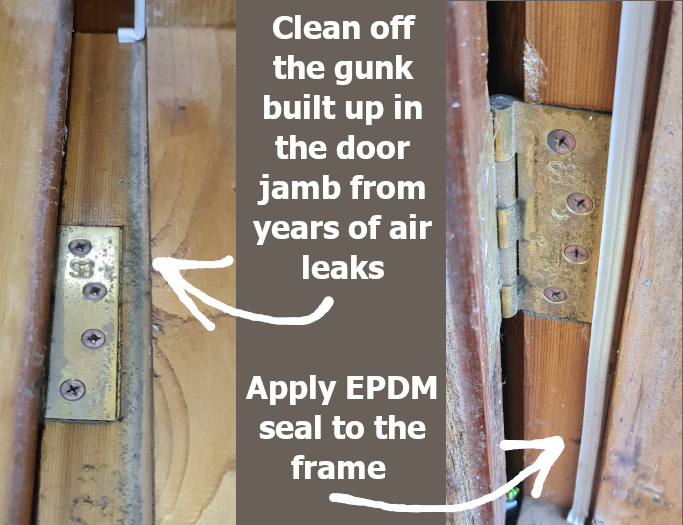
DIY insulation tip: start with the basics. Draft-proofing doors and windows prevents energy leaking (or, in my case, pouring) from your house.
How’s Everyone Holding Up?
I’ve changed the names to protect the guilty, but people are somewhere between nervous and resigned. Or both. Overall, there’s a tone of acceptance that I find sadly lacking in the sensational media.
Mark Thomson
Wearing a beanie, long johns, woollen undershirt, 2 to 3 layers of clothing, drinking a hot coffee. 11watt light globe on. Warm as toast with minimal consumption.
You/we, aren’t going to buy our way out of climate change.
Jim Simpson
Mark Thomson Don’t assume that us skinny folk with our heaters on aren’t also padded up like the Michelin man! I couldn’t afford to run a heater enough to not be layered up when it’s cold.
Chris Omealy
Freezing. With no underfloor insulation and our ceiling in need of a refit.
Coral Mallard
Yes the consumption gave me a fright! I can’t look at the monitoring app anymore.
Robin Millar
Coral Mallard oh god I just looked! … when good monitoring goes bad!
Rohan McGlew
Too scared to look.
Adan Worthley
Not much you can do to buck the weather.
Guy Dua
Minus 6 in Canberra tonight, my RCAC outdoor unit will be a massive ice cube.
On the left, you can see my air conditioner. The dark spot above it is thanks to the installers not bothering to refit my insulation properly. More poorly fitted insulation batts on the right leave cold, dark gaps in the coverage.For an utterly random snapshot, you might find a few figures interesting. At my place, it’s 9ºC outside and 11 in the hall. Thankfully, I’ve built it up to about 25ºC inside in preparation for heading to bed. It’ll likely be 16 degrees by tomorrow, leading me neatly to back to my first point: Australians build crap houses.
A Few Changes Can Make All the Difference
The good news is, with some guidance, we can all make a much bigger dent in our bills and really improve home comfort with simple energy-efficiency measures. It can be as simple as sticking some bubble wrap on the windows or getting a door snake to counter some of the issues caused by poorly built housing.
It seems that a lot of Aussies agree with this:
Darren Wisemann
In SA…Cold nights, but don’t need any heating with day heating (all windows face north), & deciduous trees out front have dropped all leaves. Jumper did the job.
James Coast
Pretty happy with our new insulation – 2ºC outside overnight and temp only dropped to ~18ºC without heating.
Barry Walls
We live on the Monaro Plains, near the Snowy Mountains. The BOM reports…it is currently -7.4°C…We haven’t had our hydronic heating on since last Sunday, and we only put it on for two hours then…Currently it is about 20°C throughout the house, and I predict it will be about 16°C when we wake up in the morning. We won’t need the heater then either, because the big heater in the sky is scheduled to kick in at about 7:20am.The real moral of the story is Australians need to build better houses.
Stan Michaels
The moral is that we need better building standards. In western Europe with the passive houses you don’t need an energy source for heating. It is enough to cook a meal in the house once a day to stay at +20 inside. And it gets cold there, outside goes to -15 to -25 over night time. We are above 0 in Perth and inside is colder than outside. We are stuck in the last century with overpriced housing industry not managing even keep a structural integrity in some cases.
Of course, better homes and insulation are great, but they come with a higher initial price tag.
Fortunately…
Help May Be Coming
From mid-2024, the Nationwide House Energy Rating Scheme (NatHERS) will expand to include existing homes, with ratings available from mid 2025. It will be a tool that qualifies you for cheap finance for efficiency retrofits and also identifies how well a building performs when you’re buying.
Considering the value that a good solar energy system adds to your dwelling, in both energy terms and capital, it can make a significant difference. Imagine where we’d be if the home insulation scheme was still running and there hadn’t been a lost decade in energy policy…
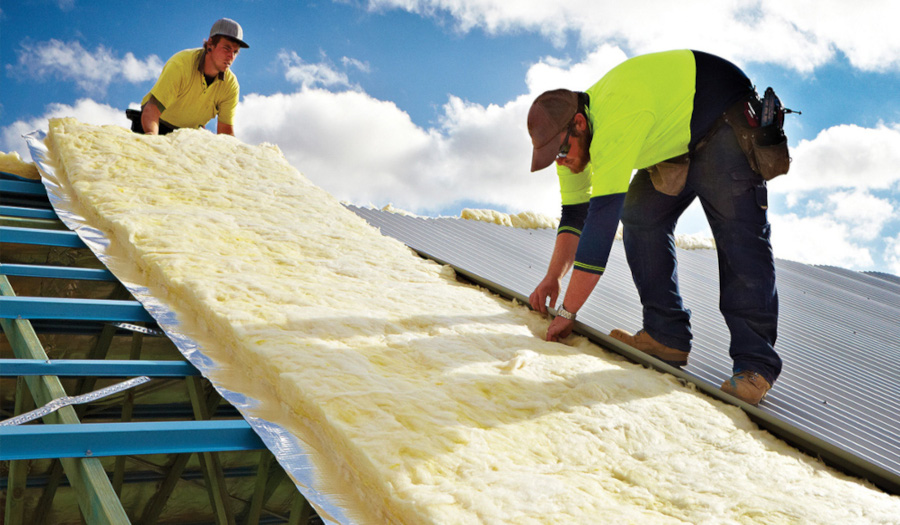
Anticon blanket installed under roofing iron is great insulation but sometimes harbours condensation.
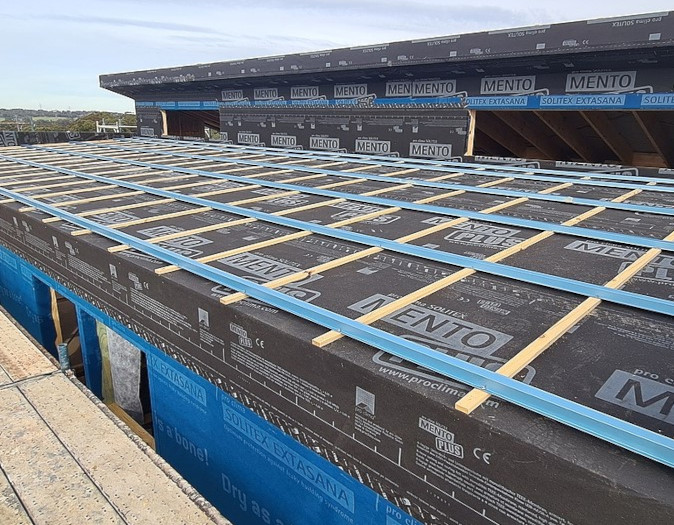
This is how you properly frame a roof with a permeable membrane and a hard air gap to offer a condensation path and insulation without a thermal bridge into the house.
Watch Out For Condensation
As we electrify everything and get rid of gas, we must consider how we manage moisture and what devices we use for heating and cooling.
Efficient houses that are well sealed may not be as cold, but they can harbour mould, especially if you’re bringing damp clothes inside to dry. Condensation can turn up in weird places and track into timber or plaster parts of your house that end up rotting.
Choose Your Air Conditioner Wisely
For heating in a cold climate, you must select an air conditioning unit for heating at the ambient temperature to get enough capacity. In short, the heating capacity reduces as the temperature outside reduces.
This has given heat pumps a bad reputation for heating, but in reality, it’s all about getting the technical details right. For example, a Daikin 5kW (cooling) unit will provide 6.1 kW of heat at 6ºC outside. So what happens when your place hits minus 10ºC? It’ll only manage 4.11kW heating, and you must consider defrost time.
An undersized unit will run its defrosting element more. When it’s really cold, an electric heater inside the home can help the heat pump start up quickly and run more smoothly.
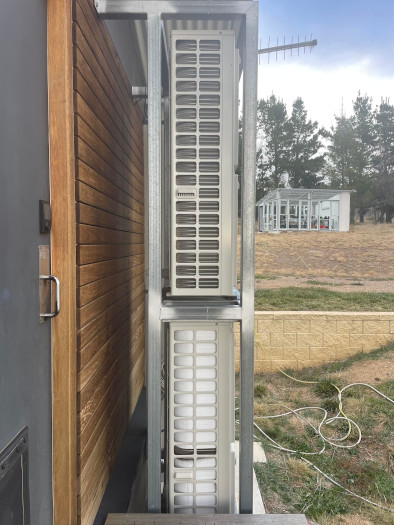
Pro tip: Mount your air conditioner a metre above ground level, and it will be far less likely to freeze (like the lower unit pictured here).
This is a problem we have to get right. If your A/C unit is rated to -5ºC but gets to -10ºC outside, everything is out the window regarding efficiency and expense. In extreme cases, you might find that a poorly chosen machine won’t work.
Scandinavians often use ground source heat pumps and typically supplement with a wood heater (and, of course, have much higher quality construction than Australian tents, er, houses). However, in the US, air-source heat pumps are more common and designed to run in freezing, snowy climates.
When buying an air conditioner for heating, ensure it will cope with the local weather. You don’t want an air conditioner salesperson telling you everything’s fine, only to find out the machine doesn’t work and you’re cold all winter.
Please don’t misunderstand me here – I’m not trying to give ammunition to those claiming ‘heat pumps don’t work in the cold’. The truth is: badly specified heat pumps won’t work in the cold. Well-specified, and thoughtfully installed ones will be fine in any temperatures found in Australia.
So How Can We Stay Cosy in Years to Come?
I may sound like a broken record, but many Australians live in thoughtlessly orientated, badly built, poorly designed, uninsulated, single-glazed, oversized, glorified grey tents. Pretty crazy in a rich country that regularly deals with extreme temperatures.
To combat these failures, we use vast amounts of energy to make our homes liveable. Now that energy prices continue to climb, our lax standards are coming back to bite us, and it disproportionately affects the old, the marginalised, and the renters, proving again that it’s expensive to be poor.
Fashion is partly to blame, with many buyers happy to spend tens of thousands on trendy aesthetic touches1, but loath to spend the same on better insulation or glazing. I think what we need to do (besides getting more solar) is demand stronger regulation and enforcement. How many six-star project homes are truthfully six-star energy efficient?
In the meantime, making a few changes, like insulating your leaky doors, can help make these cold winter nights a little more comfortable and keep the bills down.
Ultimate Solution = Solar + Thermal Envelope
For most Australians, the winter heating load comes with a substantially lower solar energy yield. There are two ways to get more solar electricity in winter:
- Tilt your panels towards vertical to catch more of the lower winter sun
- Add more panels
The latter is by far the easiest option for rooftop solar. Having enough solar power to run your heating on a winter day is a great feeling – and it’s a good reason to fill your roof with solar panels.
To check how much energy you’ll get in summer compared to winter, our Solar Calculator can help:
This is for a 6kW solar system in Adelaide split east-west:
If you want to average 20 kWh per day in June from this roof, you’ll need twice the panels.
Combine big solar with a good thermal envelope, and you can heat your home with the sun in the day, and ride through the cold evenings thanks to the thermal mass.
A passive solar design can achieve this without the solar panels – the sun streaming through north-facing windows and heating your thermal mass. But that’s a big job for renovators.
If you are building, you can think about passive solar design. But also please put aside money, brainpower, and time with the builder to ensure your insulation is maxed out and properly installed, your windows are high-performance, and your gaps are sealed2. It won’t just save you tens of thousands on energy bills; it will make your home a happy, comfortable place, even in midwinter.

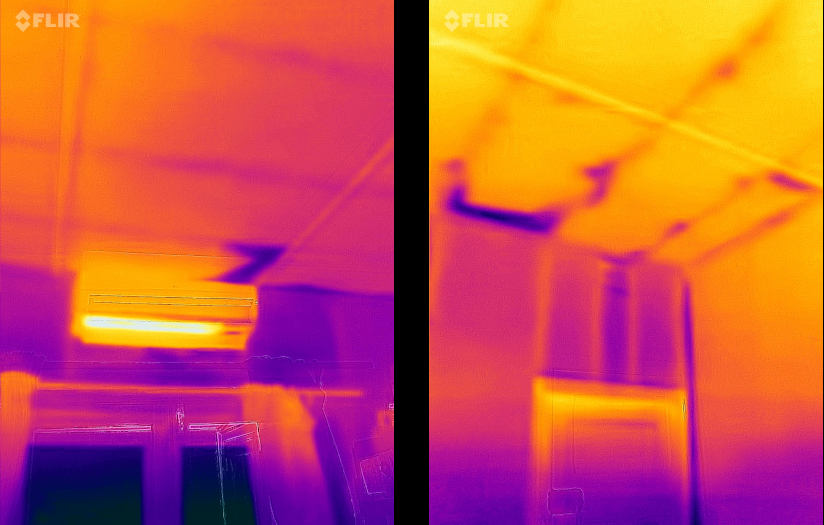
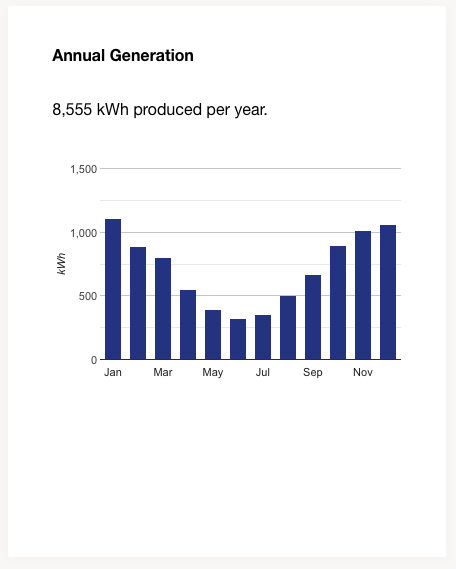
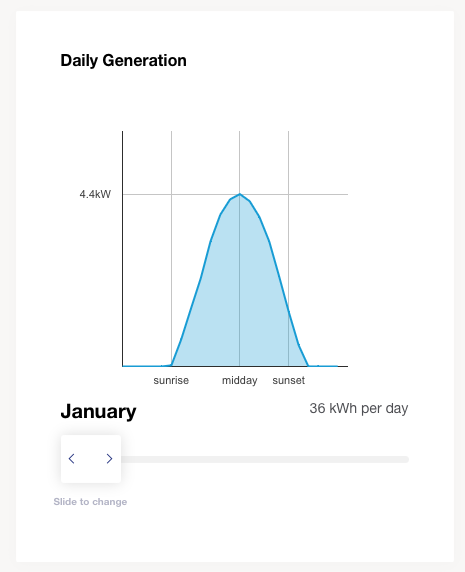
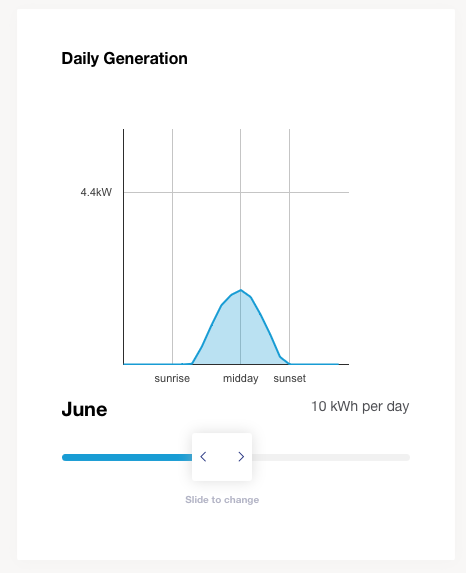
 RSS - Posts
RSS - Posts



Had a 11.78 kW solar system installed last year, with Powerwall 2 battery. Live in the coldest city (on average) in Australia. Temperatures have reached almost -10 this winter. Have Panasonic and Daikin heat pumps. Replaced all of the glazing with UPVC-framed double glazing at the beginning of the year.
So far this winter I think we’ve had only 2-3 days where we needed to actually buy electricity from the grid that wasn’t fully balanced by the exports. Haven’t even needed to swap to a time of use tariff. House is warmer than it’s ever been, and using less energy for a lot more heating (added extra heat pumps to rooms previously unheated).
This was a long-term project in the planning (and saving), which came together at just the right time for us.
Thanks Nick,
It’s great to hear about success stories, especially when you cite such challenging conditions. You’re showing it can be done and that’s a great example.
Cheers
We are so very lucky, last year we bought a house in Beaufort, by the end of the decade it will be 100 years old. The house used to be a weatherboard and when I say “used to be” what I mean is that it still is, but at sometime it’s had a layer of boarding put all around the outside and stucco added over the top, I found this out after having the electrical system upgraded. Then I found out we also have 2 roofs and we found this out when I looked in the loft and noticed inside is a one corrugated roof and outside us another. The back was added on sometime in the 70/80’s I can tell this by the mission Brown single pane window frames, the windows down the sides and from are original timber with headlight art deco windows at the front. All the internal plaster is horse hair plaster slapped onto horizontal timber boards and about 20mm thick both sides, the cornices are beautifully art deco of which I have never seen before in the main room it’s over 600mm wide on the ceiling. With a huge rectangle centre rose. We are soon to get all the 70/80’s windows replace with double glazing, but not the Aluminium stuff.we couldn’t afford the fancy double glazing but the UPVC was within our budget, If I were still working we would have bought better quality. The whole place has been insulated well and we have heat pump Aircon, hot water and dryer, 6.6kw solar system and upgraded our garage electricals for our EV. I recently added secondary glazing to the front 6mm acrylic as I don’t want to replace the front lead light windows. I need to somehow seal the old fireplace in the main room better, but we won’t get rid of it because once again it’s a beautiful Art Deco thick black steel fire place, over the 12 months I have lived here I have appreciated the house more, it can get cold in the winter but we didn’t run the Aircon at all, just the ceiling fans a few times, these have now been replaced with more modern efficient fans.
Great story of a lot of work!
On UPVC, i think they’re actually the best window framing material, not a second-best. Zero maintenance, fantastic insulation. Look great too.
It may sound a bit rough but if you want to block the chimney and it is not in use the following might work for you as we did it quite easily. I used a couple of garden rubbish bags make sure the inside perimeter is at least equal to the width of the bag x 2 and then I got a mate up on the roof to drop a light rope folded in half down I assed isocyanate two-part industrial foam 2×1 liter tins A and B and then tied off the bag securely and with the looped rope my mate pulled it up the chimney to a narrow section and we waited a couple of minutes for the foam to expand and push the bags firmly against the sides of the chimney all done just pull the rope out. Yes, the chemicals are toxic so only use them with the correct PPE. If it ever had to be removed a length of timber or steel rod on a rope would break it up. I then capped the top of the chimney with a piece of galvanised steel sheet and no more air leaks.
Ian that solution is gold. I’m stealing that idea.
Australian building standards are very frustrating. I built a new house in 2016 in North-west Sydney where we’ve had temps from -4c around 6am in a winter morning to 47 degrees around 2pm on a summer afternoon.
I was already somewhat cognizant of insulation ratings, insulated glass and other topics, but the amount of research and knowledge required is overwhelming to even technically minded people, and it really shouldn’t be on the consumer to be telling project home builders how to build houses to be efficient. The building regulations should!
Whilst my electricity bill is currently under control due to my solar (even without a battery I haven’t paid for power since September) and relatively efficient house and choices, I would LOVE to have a do-over and build a Passive-house certified design where I didn’t have to rely on 13kw of solar and an 18kw Daikin Heatpump Aircon to keep a habitable temp inside year-round!
And lets not even get into the internal moisture issues of Australia’s recent history of half-baked attempts at making less-leaky houses.
Anthony you are so right. The elephant in the room is how do we address all the substandard stock of existing housing? If anyone else builds a new poorly insulated home they deserve all the pain they get.
The existing stock is the real issue as tearing it all down will not happen. We have removed and installed new ceiling insulation which is about three times.es the rating. I should say we had a “reputable” contractor do the work. We also had the cavity brick walls insulated at the same time.
Checking with a thermal imaging camera revealed many cold spots in the ceilings and interestingly a cold band around the top of all the wals on the outside of the house? Yes the inside brick wall is several courses higher than the outside brick wall leaving an uninsulated single brick band with a skim of plaster on the inside. This was the largest single heat loss point in the house and I think this would be the case with almost all double brick construction houses.
About a thousand dollars later courtsey of big green box I had made good all the leaks including the cold band. It took a couple of months. Yes the house is warmer and we also installed double glazed windows and doors but screwed up by not getting thermally broken aluminium frames. Duh.
So now we walk about in relative comfort on a cold concrete slab which was placed directly on the ground by the original builders 40 years ago. This is a real problem for a huge number of people particularly in WA where such rubbish construction has been the norm for the past 50 years.
Anyone who has a solution will make a fortune as placing heating on top of an uninsulated slab results in significant losses when you try to heat the slab. Heavy carpet seems to be the best I can come up with.
The folks in rental properties are properly screwed as few landlords are likely to undertake such measures and if they did the rents would surely rise.
This seems to be an interesting legislative challenge to incentivise upgrades?
Hi Ian,
You raise some great points. I have often thought there would be a lot of jobs and economic activity created with incentives such as the “pink batts” insulation scheme. Sadly that phrase has been forever linked with “failure” because of a sustained campaign of disinformation put out over so many years of propaganda. It would however give us a lot of enjoyment and employment. Jobs for white collar engineers and architects to audit existing buildings and design appropriate retrofits. Then another round of blue collar employment to carry out the work.
I imagine you could save a lot of housing from the wrecking ball and preserve a lot of invested energy by cladding with insulated render or styrofoam. Tearing off tile roofs and installing more insulation, possibly simplifying the roof line to accept more PV solar as well. Double glazing, window shades, deciduous creepers, all the tools need to be used.
If landlords are going to negatively gear/dodge tax it should only be because they are improving the housing stock.
The first thing in any old house is to insulate the ceiling. There are lots of uninsulated ceilings still out there. First thing I did in my first rental property, bought in 1984. It reduces the mould problem that can happen. The unit is in a group of 6. Mine is the only one that has insulation. I’ve also crawled through lots of ceilings that owners have paid to have insulation installed but the bats are up in the roof space still packed in the bags unopened. It pays to check before handing over the cash. Don’t know if this is the same all over or just around Victoria.
I recently walked through a brand new house for sale that was missing the cornice in the kitchen behind overhead cupboards and I could see blue sky through the roof! So much for draft proofing and insulation requirements.
Also can’t understand why new builds with the garage built into the house don’t ever put insulation in the wall between the garage and the house.
You need to remember that just sealing a house to keep the heat can create problems though. Allowing proper ventilation seems to always be ignored.
We made the mistake of installing CO2 sensors in our house. While not perfectly insulated, our bedroom CO2 monitor reaches well over 2000 ppm within 3 hours of our bedtime. We have to crack open a window to get it back below 1000ppm.
Insulation can certainly improve heat retention but ventilation is still needed. I’m actually reluctant to fully seal the house as the drafts seem to keep CO2 levels at reasonable levels.
Thanks for the observation Tony,
I did allude to condensation problems in less leaky houses but air quality is another issue we need to address with building standards. Have you ever looked at HRV systems that will filter, ventilate and recover energy at the same time?
We kept the old gas light vents in our walls, in our old double brick home, for that reason. Everybody advised us to seal them, but they provide pretty good gentle ventilation all year.
I have seen some of the wonderful fairyland homes on Grand Designs tv with their airtight castles terraced down north-facing thermal mass rockfaces whose owners would not be having heating or cooling cost problems in an uninsulated home.
I was a bit short of rock faces for my level site build in cold E Melbourne suburb so having only ceiling insulation and draught excluders I will be following your advice re double glazing my costly heat sink of an aluminium wrap around corner window in the living room to help my split system.
So lucky that I opted to pay the extra $150 or so on installation to get its radiator well off the ground without realizing the benefit till I read your article.
Grand Designs is just ludicrous sometimes but it does demonstrate just how we should be building, if only the existing building industry wasn’t so recalcitrant. I know of at least one “Young Builder Of The Year” who is intent on handing back the award that the Master Builders Association gave him… because that industry association is -proud- of their lobbying efforts to delay introduction of 7 star building standards. It flies in the face of any sensible outcome other than making fatter profits on cheap rubbish houses.
You take what you want from Grand Designs and don’t worry about the Architects waxing lyrical about stuff.
I saw 1 UK episode back in the dark ages where they used Insulated Concrete Forms and it was instant “lust”. Unfortunately I was only a couple of years out of a divorce so it wasn’t a goer.
Nearly 15 years later, in my 60s and retired it was a goer. So I Owner built and went down that path. As the ICFs (Thermacell) were structurally rated for double story I used them for my Footings instead of bricks. That way my Slab was insulated, between 300mm and 600+mm, that removed the issue raised by Ian’s comment above.
I also double glazed everything you could see through, except the Oven and that came triple glazed. 😉
I used a Builder for stuff that way beyond my pay grade, Slab and Roof stuff. His comment after the building was sealed but still not completed was: “We should be building all houses like this”, I said I’ll be your Consultant and charge $50.00 and hour, you’ll see a lot of me in the design and early construction stages then you wont.
I never saw nor heard form him again. 8-0
I sit here comfortably at midday in the New England Region, outside its 11C and drifting showers and inside its just under 20C with the Woodfire softly hissing or whatever sounds they make when they’re fed what they like.
Woodfire, you would have the greenies banging on the door round here, they prefer you to go electric currently majority coal fired.
Eddy,
“…they prefer you to go electric currently majority coal fired.”
On current trends, it seems renewables will likely overtake black coal-fired generator energy contributions to the NEM in a few years.
Per OpenNEM, year to Jun 2023 (12-month rolling average) contribution to NEM included:
* Black coal: _ 89,000 GWh (42.6%), down from 44.4% in Jun 2022
* Renewables: 76,854 GWh (36.7%), up from 33.3% in Jun 2022
* Brown coal: _31,486 GWh (15.1%), down from 15.8% in Jun 2022
* Gas (CCGT): _6,809 GWh (3.3%), down from 3.7% in Jun 2022
* Gas (OCGT): _2,700 GWh (1.3%), down from 1.5% in Jun 2022
* Gas (Steam): _1,189 GWh (0.6%), down from 0.8% in Jun 2022
* Gas (Waste): _ _ 492 GWh (0.2%)
https://opennem.org.au/energy/nem/?range=all-12-mth-rolling&interval=1M
As for woodfires, pollution from them is causing billions of dollars worth of health costs every year. IMO, they are a health hazard for any unfortunate nearby neighbours, and probably for the users also.
https://theconversation.com/like-having-a-truck-idling-in-your-living-room-the-toxic-cost-of-wood-fired-heaters-140737
I haven’t seen nor heard of to many Greenies around here. Its 160km inland and approx 900m AMSL and the bush is full of banjo twangers, well nearly full.
As for the Electrickery, The Daily Supply Charge is $1.45, Peak usage $0.43/kWh, Off-Peak $0.295/kWh and Shoulder $0.375/kWh. I have as little run off the grid as possible.
As we have forest almost all around us, my heating is from locally sourced renewable timber.
As a migrant, I can still shock people in The Netherlands when I tell them we are still waiting for the double glazing revolution, about 60 years after it became common practise over there…
Keep up the good work Laurens.
We need to learn…
Laurens, we left the Netherlands in 1981 but never heard anything about double glazing. How did we miss that revolution?
FYI
I visited Birkenau concentration camp and I noticed the old Polish army barracks (taken over by the Nazis) had wood windows with double glazing. What lessons have Australians learned about anything since then?
I like the Professionally Frugal approach
Yet to break the AC seal this Winter in temperate Adelaide. I think the lowest the living end of the house has gotten to is 13.9C.
SWMBO is very happy with her heated throw as is the Traitorous dog
We installed a Northern Bay window and glasshouse (on the cheap) and then got built out. So the house struggles a bit this time of year.
I have added some optical grade acrylic as secondary glazing to some doors and windows this year which I think is helping a bit
For north American comparisons, remember that their cold air is usually very dry, north wind of the Canadian tundra, whereas Melbourne cold weather is usually high humidity, so condensation and freezing on heat pumps can be worse here than there, despite being warmer. Ground source is the way to avoid that.
Apropos the value of 6 stars, over the last couple of years I built a cementsheet clad garage/workshop/granny_flat beside a 70 year old uninsulated cementsheet dwelling. For 6 stars, the granny flat has ample insulation and is double glazed. The two workshops are insulated, but single glazed, and the garage has neither. In summer,the granny flat can be 10 degC cooler than rooms on the north side of the old home, and in winter 8 or 9 degC warmer – all passive. A 90 cm deep porch on the north side of the granny flat cuts off the sun from the windows in late spring. Haven’t moved in permanently yet, but fear I’ll have to open the windows when arcing up the wood heater for hot water in winter, when insolation may not do that.
For the sunnier half of the year, there’s a 25m x 2.7m roof skillion tilted at 40 degrees to grab the winter sun. (We’re at 38 deg S latitude.) There’s also a 40 deg west facing hipped roof that’ll take 8 panels to grab what’s on offer after the sun has slid off the north facing arrays. (E.g. for late aircon on a 43degC day, _without_ battery drain) An additional 10 kW array will go on the old roof, more or less flat, to bring the total to about 23 kW. If that can give about 6 kW in winter, I’m on a winner, as we’re off-grid.
There’s mid-house masonry forming the wood heater alcove, woodbox, and elevated HWS alcove. Proximity to the wood heater charges that heat bank when needed. I’m not sure if I’ll benefit from honeycomb curtains, but they’re a very nifty cold night insulator on single glazing. (Advertised in Renew magazine, but doubtless googlable.)
Here in the Dandenongs, I burn at least 6 tonnes of firewood over winter, as there was no 6 stars 35 years ago when I built. The neighbour says it’s $400 per tonne for Redgum, so this retiree is glad to be self sufficient there. (For naysayers: My 2 sq. km. of forest still achieves a carbon negative lifestyle.)
Now if I can just finish the renovation, to subtract one from the housing shortage.
Draft-proofing is massively underrated.
Firstly you don’t have to heat your house to 23 degrees C if you don’t feel drafts. That’s a big saving, since every degree less saves approx. 10% on your bill
Secondly the overall heat that is needed to heat a house is dramatically reduced if one can seal a leaky house with 20 air changes per hour to a house with 2 air changes per hour. The air mass needed to be heated is reduced by 10.
For comparison, a passive house standard demands 0.6 air changes per hour at 50 Pascals (or a howling wind).
A Passive House must meet the following criteria:
More at: https://passiv.de/en/02_informations/02_passive-house-requirements/02_passive-house-requirements.htm
1. The Space Heating Energy Demand is not to exceed 15 kWh per square meter of net living space (treated floor area) per year or 10 W per square meter peak demand.
In climates where active cooling is needed, the Space Cooling Energy Demand requirement roughly matches the heat demand requirements above, with an additional allowance for dehumidification.
2. The Renewable Renewable Primary Energy Demand (PER, according to PHI method), the total energy to be used for all domestic applications (heating, hot water and domestic electricity) must not exceed 60 kWh per square meter of treated floor area per year for Passive House Classic. .
3. In terms of Airtightness, a maximum of 0.6 air changes per hour at 50 Pascals pressure (ACH50), as verified with an onsite pressure test (in both pressurized and depressurized states).
4. Thermal comfort must be met for all living areas during winter as well as in summer, with not more than 10 % of the hours in a given year over 25 °C.
All of the above criteria are achieved through intelligent design and implementation of 5 Passive House principles:
– thermal bridge free design,
– superior windows,
– ventilation with heat recovery,
– quality insulation
– and airtight construction.
Passive House! Definitely the way to go. As above, the houses are fully sealed, with an energy recovery ventilation system (so air is heated/cooled coming in by the air pumped out. About 90+% efficiency.) The walls are super insulated, & sealed so no air leaks. Air leaks can cause moulds to grow in timber/insulation (so causing black mould in some Aust homes.).
I am designing my own abt 120M sq 2 br retirement house. It is to have about 200mm of insulation in the walls & ceiling. Homes now should have ventilated roof space, & the area between the outer skin & the vapor barrier can be ventilated too. (Vent-a-roof ridge ventilation & air entry low in the walls: Keep the heat out in summer & the insulation keeps the warmth in in winter.
Designing a Passive house is a learning curve for me: one must be careful not to overheat the house with Solar gain. This will be my 5th house, & totally different. btw, building a Passive house only adds 5-10% to building costs, but saves that in the first few years of ownership.
Hi Doug
Where did you find the 5-10% number for extra costs. Our architects told us +40% for building a 8 star home compared to six stars. I reckon they just made it up because they don’t know any better.
Thanks,
Diego
Diego I recently toured Adelaide’s first genuine certified with a glass plaque from Germany passive haus. It’s a display for https://www.endurobuilders.com.au/ and they can tell you what the premium is, but it’s a longer term benefit which repays the upfront cost.
Though Passive House is likely over-engineering in temperate climates. Just as anything above double-glazing (triple, quadruple etc.) is. It’s a system designed for climates that go into seriously cold temperatures.
Nick, your statement is not true.
Energy use for heating and cooling is calculated for each individual passive house and climate zone. Therefore adjustments are made to reach the 15kWh/m2 per annum target for living spaces. The tool to do this is the PHPP tool or the Passive House Planning Package. It allows to adjust each element of the house. Nothing is over engineered, it is just calculated right.
That is very different to let’s say a six star home, where often the deemed to satisfy rule is applied. It means a builder/architect can add a star just by installing a fan on the patio because it is assumed that the occupants will spend time out there on hot days and will save on aircon. Of course the aircon is running inside and the occupants sit outside and the energy use is even higher than anticipated.
Another difference between Energy Star and Passiv House is that air changes are measured twice during the build. That means the owner has a proof that the building was built to and achieves the target set.
In contrast, in an energy star home nobody is checking anything. It is simply build to building plan, that’s it. No checks and no accountability. And as we all know how builders behave, they get in and out as quickly as possible with the least amount of trouble possible, with cutting corners everywhere: insulation companies dropping unpacked insulation into the attic without installing it. Electricians ripping out insulation without reinstalling it. Penetrations for pipes or electrical conduit are not sealed. Builders leaving big gaps in the building fabric in wall corners, between the bottom plate and the slab, around windows or installing simply stuff that was specified differently on plan to save money. It is the wild west.
The result is six star homes as per design perform like a 2-3 star house. The owners does not get what they paid for. Many studies were done on this topic.
In Passive Houses nothing is over engineered, it is just calculated right.
Thanks Diego,
As a licenced builder & supervisor, having worked in the building industry for 20 years I can assure you many Australian builders are cowboys and many more are just cattle who are easily spooked by changing anything in their daily routine. These workers just don’t know any better and don’t care anyway. The “smarter” builders running the show are part of organisations like Master Builders, who congratulate themselves on the success of lobbying efforts to delay the introduction of 7 star standards.
Anthony, I completely agree with your statement.
The question is, how do we change the industry and secondly how can normal people make sure that they get better homes built without holes in the building fabric and insulation properly installed in the ceiling and walls.
A working mandated energy star rating would be a start, if it were not so flawed.
That’s why I’m a big fan of the Passive House standard. It is based on physics (max 15kWh/m2 per annum), calculations (Passive House Planning Package – PHPP) and measurements (blower door test) during and after the build, unlike many other standards.
I would not care that much if climate change was not a problem. Those who want to pay too much for heating their home, so be it. But if we want to be able to make renewables work and fix climate change, we urgently need to change the rules in place and the minds of the building industry.
Diego
PS
Just yesterday I plugged two 25m fan openings into the attic and two window ventilation mesh openings measuring 40 x 10 cm in a property. They were open all the time, summer and winter, losing lots of energy. This equates to having a window open all year round. Doors have no seals either – seems a thing in Australia.
And our neighbours’ son lives and works in Canberra and they have a big mesh in the bathroom window which undoubtedly ventilates the bathroom, even at zero degrees outside mind you. I don’t know how they can shower in there in winter. Well, they have a gas heating that sounds like a jet engine when it is running, perhaps that’s why?
My take on almost all the Builders I have met around Australia over the last 40+ years is that most of them put the books down once they finished their Apprenticeship and never read another word.
Your carpetless floor might feel cold but it could be conducting some heat back out of the ground that it absorbed in summer.
Even in Canada’s climate, the ground temperature under an ininsulated basement floor will increase over tje first couple of years, but you have a place to retreat from the 40 degree summer heat that 18 hours of sunshine delivers.
Every house sits on a tremendous thermal mass, but it usually sits unused.
Of course a comfortable Canadian house might also have 12 inch insulated concrete form walls and a foot of fiberglass fluff above the ceiling, and be close to airtight.
In Eastern Ontario, former partner and I renovated and insulated an old farm house so that it would pass the candle test. Candle test? Being able to heat the house with a candle burning. We looked at solar panels and passive solar but the sun barely rises over the horizon in Cdn. winter.
From the article and some of the comments, it sounds like the candle test in Australia is whether you can keep a candle lit inside the house on a windy day.
Yes, it should be possible to insulate and seal almost any existing house to be highly efficient. And a well built house reduces or eliminates the need for mechanical cooling in summer.
Harold Orr’s work with the Saskatchewan Research council came to the conclusion that winter solar heating in Canada just wasn’t practical (despite a lot of political pressure to pfind that it was) It required an almost perfectly insulated house, plus an Olympic swimming pool full of very hot water solar-heated in summer, insulated to R100.
The Drake Landing Solar Community system in Alberta got to 95% solar heat over a year, however the community heating and heat storage system cost almost as much as the houses.
Living in a 1950s weatherboard house has its challenges as far as retaining heat goes. If it’s a zero degree morning outside then the kitchen is usually around 5*. After sealing up every gap/leak that I could find, the lack of insulation in the walls and single glazing makes keeping the house warm challenging. Some clear cellophane over the glass panelled front door helps, (and is cheap as), but doesn’t look too trendy so mine is covered by a full length curtain. I recently changed energy providers and took advantage of globird energy’s free lunch option, which gives you free electricity between 12pm to 2 pm. When my phone alarm goes off at 12 I turn on the reverse cycle box air con (2.5 kw) to heat up the lounge room, and the 1000 watt bar heater in the bedroom along with a 1100 watt cooking wok and a fan to circulate the heat and dry up any condensation on the windows. In the kitchen I start up the water distiller (750 watts) because it gives out a nice breeze of warm air. I also turn on a 1350 watt microwave oven that has a heating element function and let that blow some hot air around. The 4 slice toaster is also there if it’s a particularly cold day, but who wants to hang around to press down the handle every 4 minutes!
I also add a shake or 2 of black pepper to my decaff coffees because it heats you up on the inside. So, I have a reasonably warm house from 12.30 to around 5/6 pm, Some good thermal shirts/pants help a lot, but honestly I swear we have a global cooling event happening, with more cold days than what we used to get.
Have you thought of a heat bank? While they are less popular than reverse cycle heating they will enable you to time shift your savings and they are 100% efficient. I know there is some leakage but that will be small and in the form of heat in any case.
Is a heatbank another name for an oil filled column heater? I’m going to do some googling and see whats available, thanks for the idea!
Some people will call an oil-filled heater a heat bank, but I would say a proper heat bank has more thermal mass than an oil-filled heater. Typically they have ‘bricks’ inside that store heat for hours once the power is off.
I have a heat bank and It is exaclty as Finn peacock describes. It is essentially a metal insulated cabinet the size of a small fire place, which is what it acts like. Inside are a series of heating elements and lots of iron stone type bricks that heat up to several hundred degrees which stores the electricty as heat, (acts a bit like a battery). If i turn it off it takes two days for it to cool down to a point where it is not effective as a heater.
It takes on 32 kW of electricty, that is 4kW of electricity per hour overnight for an 8 hour period (controlled load) everyday in winter. Just the ambient heat releases enough energy to keep the chill off over night. We turn the fan on and we release some of the heat usually between 5-10pm and it keeps three rooms warm. However all electricians who see it keep telling me to get rid of it and spend $11000 on ducted reverse cycle aircon and say I could save like thousands according to them but I just dont get it, I can’t see the ability to save that much.I spend $7.30 a day to run this flat out but when we first got it the controlled load power was so much cheaper that it was a no brainer that fire wood for a wood stove was like three times the cost of what we spent on power. Since then with power prices going up it is still better but now it is just competive against other sources of heating. Currently with the winter period and the shoulder heating I am expecting to spent just under a grand for house heating in the post July price increases.
So now I want to convert the heat bank to a solar source and have it heat up only when there is power available I figure that with the prices for peak and controlled load electricity and feed ins, this would mean that i could top up the solar with some peak grid power and still be a well ahead on cost overall. Then is summer the panels would be used to export power as a means of mitigating costs of the solar panels.
Hi John,
There’s some handy information on heat banks here. : https://www.solarquotes.com.au/blog/electricity-consumption-mystery-solved/
John, the 4100W total on top of the aircon usage would give you 16kW of heat with an aircon. I would talk to the landlord if you can install some insulation and an additional aircon.
It’s just plain scary what people have to deal with in Australia regarding housing.
I am the landlord Diego, and have insulated the roof with pink batts. Insulating the walls is the hard part, and I’m not sure how to go about getting the wall cavities filled up without doing some major damage to the old style horsehair plasterboard. I recently bought some insulating wallpaper from the U.K. (enough to do one large room) , but haven’t got around to putting it up yet. I did toy with the idea of drilling a small hole at the top of the wall cavity and then blowing some bean bag filler (polystyrene) into it, but there is a horizontal board in the wall at the 2 metres from the floor mark where the dado trim attaches, so it could turn into a major effort if I have to basically fill and paint the whole interior of the house, besides I’m not sure if polystyrene would pass the fire rating standards. I like the idea of a heatbank, and was thinking that if I could get one with 2 or 3 power settings then I could run it on a lower setting while the 4kw solar panels are generating some electricity on the overcast days, and crank it up during the free power period between 12pm to 2pm, or maybe buy 2 smaller banks and run one during daylight hours and the other in the 2 hour off peak period….hmmmm…I think that I will have to sleep on it and see if I can come up with a good strategy.
Hi John,
If you can bear to scroll through Facebook there is around 90 000 really helpful members on “My Efficient Electric Home” (MEEH) and they’ll offer a lot of free advice on insulation and how to go about it.
Thanks for the lead, I got banned from f/book back around 2016 for posting natural health info.
I know the feeling John,
For a long time I was banned from MEEH because I didn’t keep it Disney enough when talking about the building industry 😉
I agree as we live in an old Queensland built in 1896. Done various things but find it hard! Big windows at the back and not really suitable to put curtains on the inside. We were just wondering if roller shutters could help with heat, cold and security issues?
John, Heatpac supply heat banks in Australia their head office is in NSW but i think they have agents in other states. I have no commercial relationship with them. I woud only use a heat bank if you have either a lot of surplus solar PV in winter which in my experience is uncommon or alternatively if you have access to low off peak tarriffs.
Here in WA we have a super saver tarriff from 9am to 3pm of 8.2c/kWh which is really low compared to the standard tarriff which is 30c/kWh. Mind you they then slug you 51c/kWh at peak times if you use the super saver offer and the daily supply charge is also about 22c higher as well.
We have a Tesla battery and thus avoid the high peak charges and if it is a cloudy day I top up the battery from 1 to 3pm.
Using this approach the cost per kW of heat from a heat bank is comparable with the cost per unit of heat from a heat pump. Yes I do realise that the enviromental result is worse but it does also allow us to get off gas which we used mainly for space heating and of course removes the daily supply charge for gas.
I might have to take another look at the various offers from the local retailers, I don’t have a battery so obviously similar high peak rates would negate any savings that I would make elsewhere. I’m really interested in the heatbank idea, but I’m not going to be able to create enough heat in the 2 hours of free power to make it worthwhile, so maybe I could run one on a lower setting when my panels are at least putting out some power….I’m not really sure where to go with this, I need to read more about what other people are doing to hopefully pick up some ideas that I haven’t thought about.
No one has suggested Raised Heal or Cantilever trusses here, so I suspect they’re another often forgotten tool in the fight against freezing.
The edges of ceilings are rarely insulated properly because the top chord of the trusses (and thus the roof cladding) usually sits too close to the top wall plate, so you get a ring of half height (or less) insulation around the outer wall. The solution is so obvious once you see it.
Ye Gods, the width and breadth of comments is astounding.
Sooo many elephants in the room.
What percentage of australians actually read this, and what socio economic groups would they represent?
It’s not dissimilar to the EV car debate.
Would it be fair to say we have lower to medium income group, up to a medium to upper income group?
The wealthy “by and large don’t care” Please if you’re wealthy and worry just be aware that you’re in the minority of your group.
The poor (minimum wage, and uneducated in such things) have no say in the matter. And for what it’s worth represent the majority of the Australian voting public.
Until minimum standards are changed nothing will change.
Cyclone Tracy forced governmental change on building standards, IN! the effected areas. But it took a catastrophe for the pollies to actually do anything about it.
Aussies are tight arses (there to quote Finn I’ve said it)
My adult daughter recently bought a 4 bedroom home in Canberra, and she asked for my advice, I suggested a thermally efficient (good aspect, windows in the right orientation, well insulated, etc) She bought the CHEAPER??? House because it had a pool (in Canberra!!!?) and a view of the mountains, totally wrong orientation, BUT! it was 150K cheaper than anything comparable, 4/07/23 winter in Canberra she’s phoning me now saying how cold the house is, and with it’s all electric heating (yes I run a wood heater, go for it, but do please your proper, not FB research first) how are they going to cope with the 50% increase in electricity costs.
Sorry for the long post but I read these and think “privileged” albeit Finn with his model S or those with a “cold” spot on their ceilings, you do know how few people have access to thermal cameras don’t you?
Grahame, agree with everything you say there. I don’t have millions in the bank, but I’m certainly not poor, but I do care what’s going on. That’s why we installed solar/battery setup, to take a bit of pressure off the system (although I’ve been crying over my grid draw over the last 3 weeks, thanks to Melbourne’s winter!). And I think the poor and uneducated are not in a position to do anything about it, or they’re blissfully ignorant of things that are being discussed on this page.
A quick note about thermal cameras – people on the MEEH Facebook page mentioned that Cardinia Shire Council in SE Melbourne actually lend them out to residents. Not sure if that’s available elsewhere, but I’ll be checking with my council.
Cheap thermal camera attachments which plug into your phone are available for under $50.00 just saying.
There are also energy audit kits available to borrow from many local councils/libraries which include a plug in kilowatt hour meter and a laser surface thermometer.
Cheapest one I could find was just over AU$400?
Laser surface thermometers are available on eBay, starting at $18. Plug-in kilowatt-hour energy meters are around $16-$20., I bought an energy meter for $16. It seems to work well.